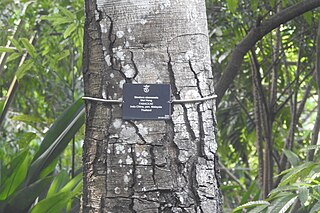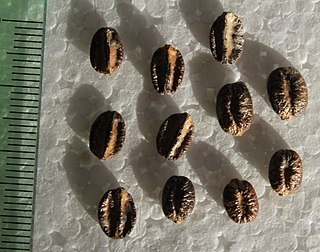
Quassia is a plant genus in the family Simaroubaceae. Its size is disputed; some botanists treat it as consisting of only one species, Quassia amara from tropical South America, while others treat it in a wide circumscription as a pantropical genus containing up to 40 species of trees and shrubs.

Sindora siamensis is a species of tree in the subfamily Detarioideae of the family Fabaceae. It has an accepted infraspecific, the variety S. siamensis var. maritima (Pierre) K.Larsen & S.S.Larsen. See taxon box to the right below, and below for details on the variety maritima. The nominate species is found in many countries in tropical Asia. Like several other species in the genus Sindora, its wood is considered valuable; the least concern conservation status may reflect efforts to replant this species, but mortality rates are high. As well as the wood, the plant provides raw material for chemical products, food and drink, and domestic utensils.
Pierreodendron is a genus of plants in the family Simaroubaceae.

Elaeocarpus lanceifolius is a tree species in the family Elaeocarpaceae. It is found across tropical Asia from Thailand to Yunnan to Nepal to Karnataka, India. It is used for its wood, fruit, and nuts.
Ziziphus cambodiana is a deciduous thorny shrub, or vine, some 2–6 m tall, found growing in secondary undergrowth in Cambodia, Laos and Vietnam, and northern Thailand.

Dillenia pentagyna, the dog teak or Nepali elephant apple, is a small tree with tortuous twigs. It is a member of the family Dilleniaceae, and is found from Sulawesi to South-Central China to India and Sri Lanka.
Homalium brevidens is a shrub or tree species in the family Salicaceae, found in Laos and Cambodia.
Dendrolobium baccatum is a species of flowering plants in the Fabaceae family. A shrub, it occurs in Mainland Southeast Asia. People use it for food and fuel.
Erythroxylum cambodianum is a shrub in the family Erythroxylaceae. It grows in Vietnam, Laos, Cambodia and Thailand. The wood is used for pickets and as firewood.
Gluta cambodiana is a shrub/small tree in the family Anacardiaceae. It occurs in parts of Mainland Southeast Asia. Its wood is used for pickets and fuel.
Memecylon caeruleum is a shrub or tree species in the Melastomataceae family. It is found from New Guinea, west through Southeast Asia to Tibet, Zhōngguó/China. It has become an invasive weed in the Seychelles. It has some local use for wood and food.
Pantadenia adenanthera is a shrub in the Euphorbiaceae family. It is found in parts of Southeast Asia. The species is used for its wood and edible fruit.
Stixis obtusifolia is a shrub or liana in the Resedaceae family. It is found in parts of Southeast Asia. The wood is used as fuel, the leaves as a tea.
Strychnos nux-blanda is a shrub or small tree in the Loganiaceae family. It is native to Southeast Asia and Assam. The wood is used as fuel; seeds are toxic, but used in folk-medicine. It is one of the plants featured in the garden of King Narai (1633–88) at Lopburi, Thailand.

Xanthophyllum lanceatum is a tree in the Polygalaceae family. It grows across Southeast Asia from Sumatera to Bangladesh. The leaves are used as a hops-substitute in beer making and the wood as fuel. Fish in the Mekong regularly eat the fruit, flowers and leaves.

Ampelocissus martini is a species of climber or shrub in the Vitaceae family. Some sources use the spelling Ampelocissus martinii. It is native to an area of Mainland Southeast Asia. The fruit are eaten by people and by several species of Pangasiidae shark catfish of the Mekong river.
Memecylon lilacinum is a tree species in the Melastomataceae family. It is usually an understorey species in closed forests. It is native to an area of tropical Asia, from Jawa to Philippines to Vietnam and the Andaman Islands and Myanmar. It is a food plant for the macaque Macaca facsicularis and a bee in the Megachilidae family.

Simaba is a genus of flowering plants belonging to the family Simaroubaceae.

Samadera is a genus of four species of plants belonging to the family Simaroubaceae in the order Sapindales. Its range is from eastern Africa through tropical Asia to eastern Australia.

Samadera indica, the bitter wood or Niepa bark tree, is a species of plant in the family Simaroubaceae. It is a shrub or tree and grows primarily in wet tropical regions, from west Africa, through India, then down through Indonesia to Malesia.








